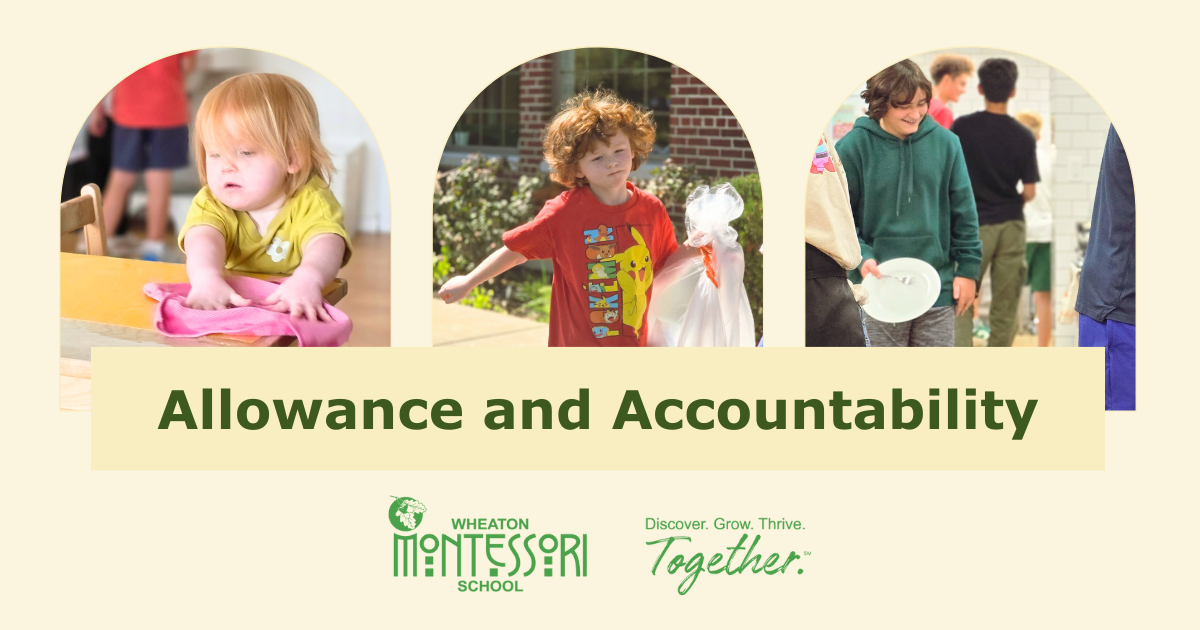
Ask Your Montessori Teacher: Tracy Fortun, Lower Elementary
Q: Should we give an allowance? How much do you think it should be? Should it be tied to certain tasks or a weekly set amount?
When I was growing up in a small town in the 1970’s, I always knew, to the penny, how much money I had in my possession. We had a magical establishment known as the “Little Store” (which probably sold all kinds of things, but all I was interested in was their extensive assortment of Tangy Taffy). We could walk into the Little Store with fifty cents and come out with enough loot to keep our friends on a sugar high all afternoon. We thought our purchases through carefully to get the best value for our dimes and nickels. We lent each other money and paid it back (mostly). Health risks aside, this was real experience with handling and counting money with some major decision-making thrown in.
Today, the concept of money has become completely abstract. Children never see us handling cash. We handle all our transactions with plastic cards or by waving our phones at people. My husband and I even pay our son electronically for mowing the lawn! These days, parents must manufacture experiences for children to handle money. So, how can an allowance provide some critical experience in saving, spending, and understanding money?
Here’s what worked for our family:
Give some age-appropriate chores that are NOT tied to an allowance but are expected as contributing members of a household. Every member of the household should have responsibilities. In my house, the kids’ basic responsibilities included picking up their rooms, emptying the dishwasher, feeding the dogs, and taking out the trash. Eventually, they also did their own laundry (around age 10).
A child of 2 or 3 can sort silverware into the drawer and help put away laundry. If you begin incorporating household tasks into their daily routine early on and stay consistent, you get far less pushback than you would imagine as they get older. But far more importantly, when a child is counted on for help with the work of the home, it provides a sense of belonging and builds confidence.
Give a small “base” allowance that is not tied to jobs. Just as Mom and Dad have a certain amount of money for personal spending, this money was allotted to them to contribute to members of our household.
The big question is, how much? The amount will naturally depend primarily on the family’s circumstances and discretionary funds – the experience handling money is far more important than the amount. The base allowance should be a meaningful amount – enough to blow on something small immediately, or to be able to save up for something desired within a reasonable amount of time. I see many parenting experts suggest that the base allowance start around the age of 6 at $6 a week, with a dollar increase with each birthday.
Provide the option of earning more money by doing extra chores. Starting when they were Elementary aged, we posted a list on the fridge of standing jobs that always needed doing (picking weeds, sweeping/vacuuming, wiping out the microwave or toaster oven, picking up after the dogs, etc.) The kids could choose any of those jobs to do for a little extra cash. In addition, when my husband and I had a bigger job we needed help with we would let them know upfront if this was a paid gig or not. Cleaning the garage (where we all left messes) was a “family task” and therefore unpaid. Mowing the lawn is something that we are willing to pay others to do for us, so in our house, we paid our kids to do it (starting around age 11-12).
Few Tips and Pitfalls to Avoid
- Some kids will jump at the chance to earn extra cash, while others will not be as motivated. The beauty of this dual system is that even if a child doesn’t care much about earning extra money, the base allowance still provides some important experience. Don’t fret if they seem disinterested at first; while one of my children took every extra job available starting in first grade, the other saw no purpose to earning extra spending money until high school. They get there when they get there!
- The chores offered should be
real work that helps the family. The whole point is to provide the child with a sense of how it feels to work for something you want. This purpose is completely missed when the chores are meaningless. My list of extra chores consisted of things that had to be done but that really ate up my weekends. When my kids stepped in, we often worked alongside one another, which got the tasks done faster, provided me opportunities to teach them new skills, and allowed us to spend some quality time together.
- Keep each individual child’s skill set in mind and be ready to work alongside them. Be sure the task is something that they can reasonably accomplish, with help. Remember that the purpose is to teach them responsibility. At first, you may be working alongside them, but after some time, you may be able to let them work independently.
- Clearly state expectations up front. I learned that it worked best when I wrote out a checklist, walked through the job with them beforehand, and specified that the job was complete when
all the tools are put away. Don’t be afraid to say, “Before we discuss your payment, there are a few more items to take care of.”
- Be wary of “I’ll pay you back” or “I’ll work it off” in the beginning. Until this system of working for extra cash has become well established, avoid getting into the situation of your child wanting to buy something and pay you back later. The delight in having the “thing” wears off quickly – and so does the good intention to repay you. The couple of times I acquiesced to such an arrangement, I ended up nagging them to fulfill their responsibility, and it was frustrating for all concerned. Believe me, it is MUCH easier to say “No” upfront! Some children may eventually be able to manage repaying you in work, but most are probably best off sticking to a “spend money when you have money” system.


